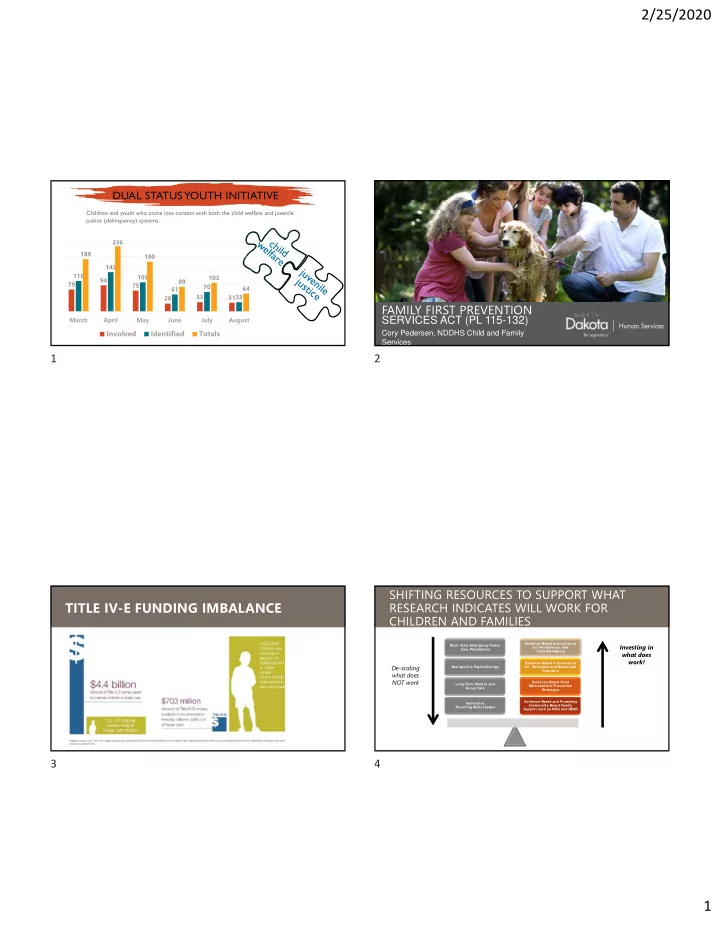

2/25/2020 DUAL STATUS YOUTH INITIATIVE Children and youth who come into contact with both the child welfare and juvenile justice (delinquency) systems. 236 189 180 142 110 105 103 94 89 79 75 70 64 61 33 33 28 31 FAMILY FIRST PREVENTION March April May June July August SERVICES ACT (PL 115-132) Involved Identified Totals Cory Pedersen, NDDHS Child and Family Services 1 2 SHIFTING RESOURCES TO SUPPORT WHAT TITLE IV-E FUNDING IMBALANCE RESEARCH INDICATES WILL WORK FOR CHILDREN AND FAMILIES Evidence-Based Interventions Investing in Short Term Emergency Foster for Permanence and Care Placements Child Well-Being what does work! Evidence-Based Interventions De-scaling Non-specific Psychotherapy for Emotional and Behavioral Disorders what does NOT work Evidence-Based Child Long-Term Shelter and Maltreatment Prevention Group Care Strategies Evidence-Based and Promising Ineffective Community-Based Family Parenting Skills Classes Support such as ACEs and NEAR 3 4 1
2/25/2020 Ongoing development NDAC rules are FFPSA of rules, policy, Stakeholder Calls passed for four Law program Kinship Navigator Monthly + website chapters! Passed planning, etc. Feb. Apr - Aug Oct. 2018 2019 Sept. 2019 2018 2019 Title IV-E Adoption State plan Reauthorized a John H. Chafee Assistance “delink” requirement under number of Title IV-B Foster Care and the savings and Title IV-B to programs through Independence describe activities: reinvestments (Sec. FY2021 (Sec. 50752) Program (Sec. 50782) 50753) Nov. 2018 Aug. 2018 Jan – Apr 2019 Aug. 2019 Oct. 2019 To reduce the length of time Title IV-B, Subpart 1, to permanency for children Promoting Safe and Stable under age 5 and National Meetings ND Stakeholder Legislative Session Contract with Implementation Families Program (Title IV-B, for States in Denver Convening in Capitol Ascend Address the developmental NDCC 50-11 Subpart 2), needs of all vulnerable Budget $$ Funding reservations for children under age 5 who supporting monthly caseworker receive services (Sec. 50772) visits, and Court Improvement Program Grants NORTH DAKOTA OVERVIEW Done in February 2019 5 6 Finalized Law, Rule, Policy Pending In discussion On Hold - Pending & Forms R eimbursement for 50% of the Title IV-E reimbursement for a child who has been placed with a parent in Reimbursement for 50% of the state’s Family Licensing will mirror the state’s expenditures on a licensed residential family-based expenditures on kinship navigator national model standards per prevention program that are well treatment facility for substance programs (S ec. 50713) NDAC 75-03-14 (S ec. 50731) supported evidence based per the abuse. (S ec. 50712) prevention plan (S ec. 50711) Finalized Rule and Application Done Done Finalized Rule & Application S tates are required to have procedures for criminal records child Offer S upervised Independent Offer licensure for Qualified Title IV-B track and prevent child abuse and neglect index checks on Living for 18+ foster children in R esidential Treatment Facility per maltreatment fatalities . (S ec. 50732) any adult working in group care ND via NDAC 75-03-41(S ec. 50741) NDAC 75-03-40 (S ec. 50745) settings where foster children are placed. (S ec. 50745) Effective October 2019 Effective October 2019 7 8 2
2/25/2020 DIFFERENCE OF RCCF VS QRTP NEW ~ QUALIFIED RESIDENTIAL TREATMENT PROGRAM (QRTP) RCCF Resident Characteristics Licensed and accredited Full family engagement • Previous/history Trauma informed treatment model Aftercare supports for 6 months • Family setting is not secured Registered or licensed nursing and • A safe bed in a group home/facility other clinical staff onsite • Placement was infinite amount of time, no length of stay requirements Level of care assessment • No specific treatment/service requirements 60 day review hearings • Most youth manage full day of school in the community without disruption/intervention, etc. QRTP Resident Characteristics: •Current/future •Use CANS domain criteria •Several areas of need of treatment/intervention 9 10 WHAT IS THE CANS? Child and Adolescent Needs and Strengths assessment Developed for children’s services to support decision making Level of care and strengths-based service planning To facilitate quality improvement initiatives To allow for the monitoring of outcomes of services Each item suggests different pathways for service planning 4 levels for each item with anchored definitions to translate into action levels The Praed Foundation is a public charitable foundation committed to improving the wellbeing of all through the use of personalized, timely, and effective interventions 11 3
Recommend
More recommend